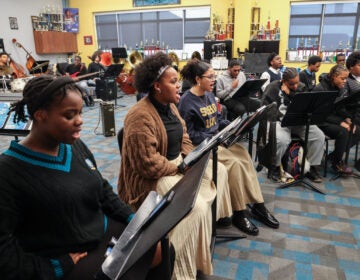In Camden, a castle under siege

This October, Camden is poised to experience a loss as devastating to the troubled city’s spirit as a funeral for one of its many murder victims.
That’s when Camden High School, with its English Tudor main building known to all as “The Castle on the Hill” is slated to fall to the wrecking ball — to be replaced under the direction of the state’s School Development Authority by a $132.6 million “campus” that is more suburban sprawl than Gothic revival.
It would only happen in one of the poorest communities in New Jersey — and especially Camden, where state control has stripped residents of their right to vote for their own board of education–that the single most historic, inspiring edifice and an enduring symbol of black achievement would be considered of so little consequence. Somehow, the over a billion in tax breaks that corporations have recently received to relocate to Camden through the state’s Economic Opportunity Act make the cost of saving the Castle seem like a pittance and its destruction that much more obscene.
Especially if a new school isn’t even put in its place.
Why would a growing number of residents not believe the SDA’s promises of a gleaming new educational complex?
Because they remember when the Lanning Square School was torn down and then-Governor Jon Corzine promised to build a new $42.4 million public school in its place in 2010–and instead, a shiny new charter named after South Jersey political boss George Norcross arose from the ashes.
Because with the proliferation of charter schools, there are a plethora of places for teens in the city to be educated. Because land in the Parkside neighborhood where the High is located is valuable and ripe for gentrification, with residents afraid of being forced out by rising property values, hence higher taxes.
And because Camden School Superintendent Paymon Rouhanifard has said publicly that he can offer no ironclad guarantee the four-year construction will actually happen.
On Monday, opponents of the plan filed a lawsuit in federal court asking a judge to block the demolition of the High’s main building, built in 1916. It contends that the school district has been “hastily proceeding with demolition” in order “to evade public scrutiny and meaningful participation.” The suit, which has no objection to the razing and replacement of the school’s other, newer buildings, calls the Castle “a point of cultural identity and pride” for the community.
In October 2016, the SDA voted to approve the plan at a Trenton meeting that invited community feedback; four hours later, Governor Chris Christie and Mayor Dana Redd held a news conference at Camden High to officially announce it, prompting criticism for haste and lack of community involvement. Activists have appealed to Rouhanifard to tear down the buildings behind the Castle and erect new ones there, but to no avail.
A feasibility study places the difference between renovating and a complete rebuild at between $4.5 and $6 million. But the new plan calls for something very different from a vibrant, bustling Camden High School that once held over 2000 students and produced the likes of famed songwriter/producer Leon Huff and professional athletes like Art Still, Derrick Ramsey and Milt Wagner.
Instead, the site will become a Camden High “campus” comprised of Camden High and three city magnet schools projected to serve 1200 students. The campus concept makes the Castle itself inconvenience. Says SDA’s Kristen MacLean: “A new school facility would also better meet the needs of the proposed small learning community method of education proposed by the District.”
Dr. Doris Carpenter is the Camden High alum who spent six weeks studying Gothic architecture to win a Certificate of Eligibility from the NJ Department of Environmental Protection for the historic status of her alma mater. CHS was was also named one of the ten most endangered historic buildings in New Jersey by Preservation New Jersey. While such credentials could ultimately win grants to help preserve the Castle, they may not prevent its demise.
Carpenter has watched in frustration as smiling alumni assemble to take celebratory “last” photos out front, and is furious that the Castle has been allowed to languish.
“The building is dirty, there’s little tree roots growing out of the terra cotta, “says Carpenter. “The neglect has a psychological impact, and they’ve pulled out all of the top level students so that the children that remain in the school felt like rejects and the teachers who were left felt like they were teaching rejects.
“Gothic architecture,” says Carpenter, “tries to establish this experience for you so that just by entering the building—without even speaking a word—you should be raised to a level above your circumstance…the building is meant to elevate you!”
My children attended historic high schools with less inspiring architecture in Haddon Heights and Haddonfield, affluent communities where nobody would dare destroy a storied institution in the service of an educational experiment. It is impossible to imagine Governor Christie coming to Haddonfield Memorial High—currently undergoing an expensive renovation—to triumphantly announce its demise and not be run out of town.
Activist Vida Neil is haunted by the planned demolition of a building where, for generations, her family has studied and worked. “The other night, I woke up in a cold sweat,” she told me recently. “In my dream, nobody saved Camden High.”
I have that nightmare, too, Vida.
______________________________________________________________
April Saul is a Pulitzer Prize-winning photojournalist who lives in Camden, New Jersey. She writes about the challenges and joys of the residents in Camden on her Facebook page CAMDEN, NJ: A Spirit Invincible. Several times a month she writes essays on Camden for NewsWorks.
WHYY is your source for fact-based, in-depth journalism and information. As a nonprofit organization, we rely on financial support from readers like you. Please give today.





